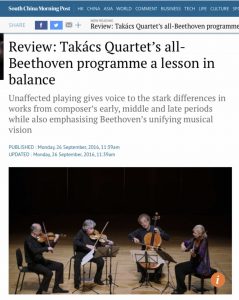南華早報 South China Morning Post
Review: Takács Quartet’s all-Beethoven programme a lesson in balance
By Martin Lim
26 SEP 2016

Unaffected playing gives voice to the stark differences in works from composer’s early, middle and late periods while also emphasising Beethoven’s unifying musical vision
Through four decades of music-making, the Takács Quartet have shown that focusing on the works of a single composer can reveal as much about the players as the music.
The quartet’s initial Bartók cycle in the mid-1980s championed the composer as a fellow Hungarian nationalist. Returning to the same works 15 years later, and with the British-born Edward Dusinberre having replaced founding first violinist Gabor Takács-Nagy, the quartet presented the composer as a well-travelled modernist.
Beethoven, however, is in an entirely different league. For better or worse (and it’s often the latter), musicians use Beethoven as a career benchmark.
Even in a thoroughly saturated recording market, the Takács Quartet’s combination of blistering virtuosity and emotional restraint made their Beethoven cycle – released between 2002 and 2005 – an industry standard. The Takács offered an efficient summary of that approach on Saturday in the Grand Hall of the Lee Shau Kee Lecture Centre at the University of Hong Kong.
As with Beethoven’s symphonies, his 16 string quartets cover the composer’s early, middle and late periods in roughly equal proportions. Taken in order, they offer a musical diary of their creator, the quartets as intimate as the symphonies are public.
The challenge in either case is striking an appropriate balance between showing different stages of a composer’s development and a creator’s unifying vision. On Saturday, it was the differences that struck the ear first.
The Haydnesque charm and wit – not traits generally associated with Beethoven – in the G-minor quartet, the second in his Opus 18 collection, contrasted starkly with the more familiar intensity of his Quartet in F Minor, Op. 95. That brooding emotional compression in turn gave way to an epic canvas of solitary introspection in the Quartet in C-sharp minor, Op. 131.
And yet, thanks to the Takács’ expressive balance, the performances never strayed from the composer’s core values. Dynamic contrasts, as well as a judicious use of silence, were blended ingredients rather than a spice rack of musical effects.
Beethoven’s natural lyricism, even if you can’t quite call it a melodic gift, was smoothly married to an underlying musical structure. Under the Takács, the same architect was always at work whether the product was a modest dwelling or a palatial tower.
Served in the fine acoustics of HKU’s Grand Hall, the quartet’s performance was something of a sonic cocktail, “dry” enough to follow the inner lines with intimate clarity yet “wet” enough to savour the blend. It was hard to know exactly where the glass ended and the drink began.
Glimpses of the Immortal: Takács Quartet’s All-Beethoven Programme. Grand Hall, Lee Shau Kee Lecture Centre, The University of Hong Kong

